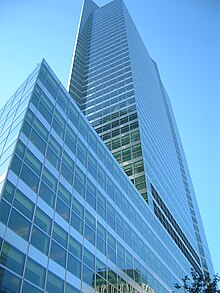200 West Street
Construction commenced in 2005 after New York City and state government officials gave Goldman Sachs large subsidies to fund the project.
[4][11][5] The curved western facade was a result of zoning restrictions, which mandated that a sightline of the Hudson River from the World Financial Center had to be preserved.
[4][12] Cobb convinced Goldman Sachs officials that a curve would allow the office space to be arranged more efficiently, in contrast with a diagonal slice.
[4][11] The elevator bank is connected to the main entrance, at West and Vesey Street, by a walkway measuring approximately 400 feet (120 m) long.
[4] On one wall of the walkway, artist Julie Mehretu created in 2009 a $5 million, 80 by 23 feet (24 by 7 m) work titled Mural and consisting of intersecting dynamic abstract forms in multiple colors.
[11] 200 West Street was designed with several environmentally friendly features, such as plumbing with low-flow fixtures, carpets with low chemical levels, and a green roof.
[20][21] The low-flow plumbing fixtures, as well as a system to collect storm runoff, can save 11 million U.S. gallons (42,000,000 L; 9,200,000 imp gal) of water annually.
[23] After the World Trade Center was destroyed during the September 11 attacks in 2001, numerous large companies in Lower Manhattan left the area or threatened to leave.
[26] In December 2003, The Wall Street Journal announced that Goldman Sachs was considering erecting a headquarters in Battery Park City near the World Trade Center site.
Local business leaders praised the project as a benefit for the neighborhood, which was still being negatively affected by the aftermath of the September 11 attacks.
[23] Goldman Sachs sought subsidies and tax exemptions from the New York state and city governments before committing to the West Street headquarters.
[26] By April 2004, Goldman Sachs had hired Pei Cobb Freed & Partners to construct a 40-story tower with a curved facade that met the environmental standards required within Battery Park City.
[25] In August 2004, the Battery Park City Authority designated Goldman Sachs as the developer of the West Street site.
[27][28] A dispute arose in late 2004 when New York governor George Pataki proposed rebuilding the nearby section of West Street as a tunnel underneath the World Financial Center.
[30][31] The state government quickly canceled plans for the West Street tunnel,[32] but Goldman Sachs continued to look for additional sites.
[37] Later that month, a state board approved $115 million in tax breaks and cash grants, as well as $1.65 billion in Liberty Bonds to help cover the building's construction cost.
[42][43] In developing the building, Goldman Sachs pledged $3.5 million toward the construction of a New York Public Library branch at North End Avenue and Murray Street, a block west of the new headquarters.
[44][45] Goldman Sachs acquired the adjacent Embassy Suites hotel to the west in 2006, which gave the company more control over the surrounding site.
[46] Shortly after construction commenced, Manhattan Community Board 1 passed a resolution mandating that Goldman Sachs devise a plan to reduce the impact of for-hire "black cars" idling around the new headquarters.
The state and city governments would forfeit a combined $321 million if infrastructure improvements to the World Trade Center site were not completed by 2009.
[57] By late 2008, Goldman Sachs intended to sublet its other space in Lower Manhattan once the 200 West Street headquarters was complete.
[60] Shortly after the first workers moved into the building, glass pieces fell from the upper floors, forcing street closures in the neighborhood.
[59] Upon the building's completion, architecture critic Paul Goldberger wrote for The New Yorker that Goldman Sachs succeeded in keeping "its risk-taking entirely out of sight" with 200 West Street's design, though he deemed it "unfortunate that almost all the daring touches at 200 West Street are inside, hidden from view".
[11] Jacqueline Pezzillo of the Center for Architecture described the building as "an indelible legacy of the financial giant [Goldman Sachs] and a tribute to teamwork, creativity, and diversity".




